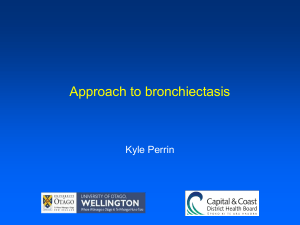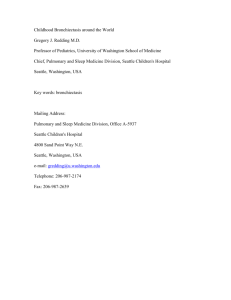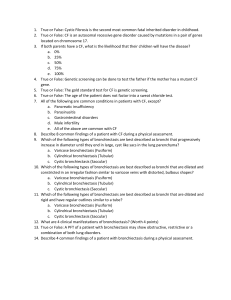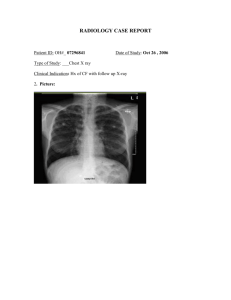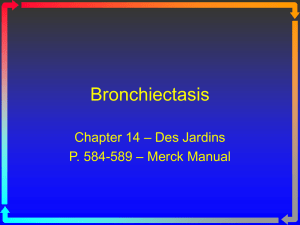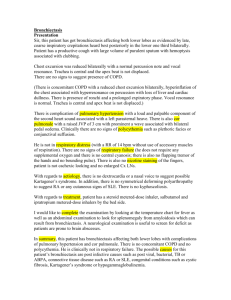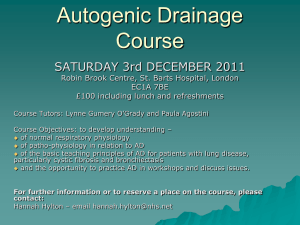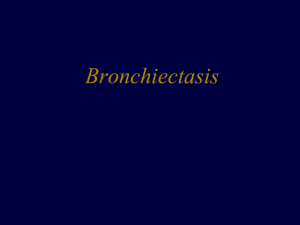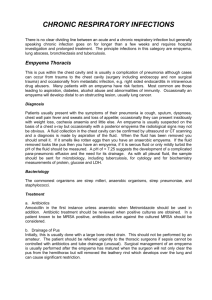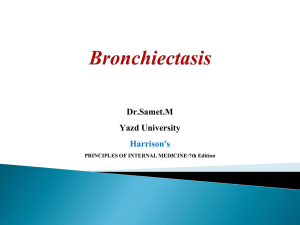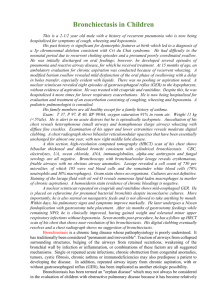Bronchiectasis Presentation
advertisement
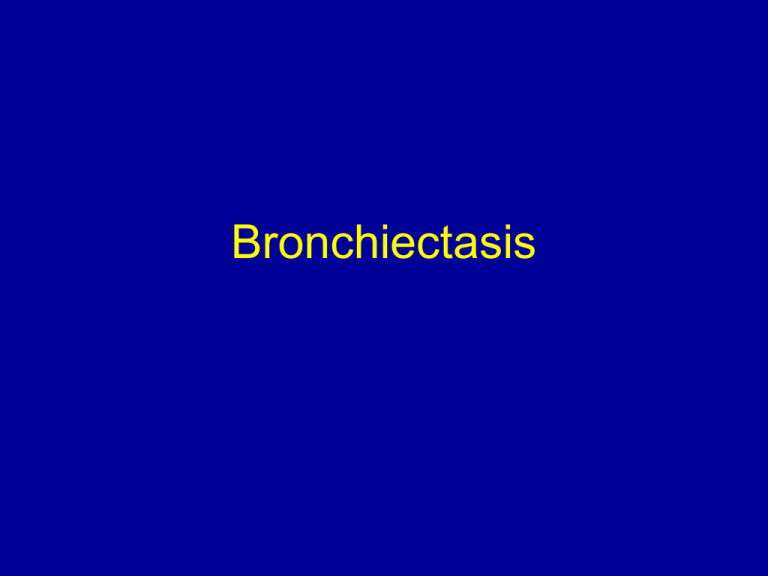
Bronchiectasis Northland • 2013 - 10 known paediatric patients with bronchiectasis in Whangarei and 4 in greater Northland. • Now 27 confirmed non cystic fibrosis bronchiectatic patients in Northland Early and effective management reduces short- and long-term morbidity Definition • Irreversible bronchial dilatation • Radiological or pathological diagnosis • HRCT scan current gold standard Chronic Suppurative Lung Disease • Symptoms of chronic endobronchial suppuration +/- radiological evidence of bronchiectasis Chronic infective bronchitis Protracted bacterial bronchitis • Prolonged wet cough • Resolves completely after treatment • If untreated may progress to bronchiectasis Bx, CSLD, Protracted bacterial bronchitis • Symptoms and signs overlap and lack specificity • Absolute reliance on radiology-based definition unsatisfactory – When to do imaging – Age related changes in bronchoarterial ratio uncertainty – 2 HRCT scans to fulfil irreversible defn – Influence of acute illness Definitions • ?chronic suppurative lung disease best overarching term Pathogenesis • Obstruction • Chronic inflammation, progressive wall damage, dilatation • Abnormal cartilage formation (congenital causes) • Common thread: difficulty clearing secretions + recurrent infections • Resulting airway injury and remodelling Pathogenesis 2 • Infections and an ineffective host immune response involving uncontrolled recruitment and activation of inflammatory cells within lower airways • Release of mediators, eg proteases and free radicals • Causing bronchial-wall injury and dilatation Causes (paeds) • • • • • • • Congenital CF Immune deficiency Primary ciliary dyskinesia Aspiration, recurrent small volume Post-infection (Systemic inflammatory diseases) Investigations • • • • • FBC Immunoglobins Sweat test Sputum PCD – exhaled fractional nasal nitric oxide and/or nasal ciliary brushings • Spirometry and lung volumes (>6yo) Invx additional • • • • CF gene mutations Bronchoscopy – FB/ airway abnormality Ba swallow/ video fluoroscopy Further immune tests – IgE, neut fnc test, lymphocyte subsets, ab resp to vaccinations • HIV • Echo (esp adults, ?pulm hypertension) Assessment of severity 1 • Clinical – Cough – Sputum – Exacerbation rate – Well-being Assessment Severity 2 Lung function • Spirometry – Classically obstructive – Repeated at each review – Relatively insensitive in mild disease, and in children – Spirometric volumes can stabilize and improve in children • 6 minute walk – Assessment functional impairment Microbiology • Common pathogens children: – H influenzae – S pneumoniae – M catarrhalis Management Early and effective mgmt reduces short- and long-term morbidity Management 1 • Airway clearance Chest physiotherapy • Nutrition • Fitness and activity • Avoidance of environmental pollutants – TOBACCO • Assessment for co-morbidities • Annual ‘flu immunisation Management 2 • Intensive antibiotic treatments – Reduce microbial load – Oral Abx and ambulatory care initially – Hospital and IV Abx + intensified physio • more severe/ unresponsive oral Burden of disease Incidence – non-CF Bx/CSLD • NZ <15yo 3.7/100 000 per year (2x CF incidence) • Central Australian Indigenous children 1470/1000 000/year • US 18-34 yo 4.2/100 000 Northland burden General prevalence NZ Maori (only) Pasifika only NZ Maori and Pasifika Northland 23/32751 10/15138 1:1424 children (0-14) 1:1514 1/2079 17/17217 1:2079 1:1013 National 1:3000 1:1700 1:650 Northland • • • • • 27 children 0-16 Almost all post-infection x1 with unsafe swallow x1 with IgA deficiency 2 other children with PCD but not Bx Paediatric Bronchiectasis Clinic • • • • Quarterly multidisciplinary clinic Currently only at Whangarei Physio, nurse, doctor Team meeting at the conclusion of each clinic to discuss patient’s plans and monitoring and discussion of issues. • Same physiotherapist in clinic as on ward – aids with continuity of care – outreach nurse also follows patient both in the community and on admissions. Aims of Multidisciplinary clinic: • To provide standardised care to children with bronchiectasis • To provide ongoing monitoring in accordance with guidelines for bronchiectasis • To prevent/reduce hospital admissions • To provide a continuum of physiotherapy techniques in the management of bronchiectasis through their childhood Aims of Multidisciplinary clinic • To develop a proactive application to deliver health care for these children and their families to reduce disease progression • To provide education and promotion of healthy lifestyles for families with the aim of reducing disease progression • To provide a central point of contact for patients and family with bronchiectasis and thus patient centred care • To provide holistic care • To reduce inequalities of health care access Presentation • Chronic or recurrent wet cough • Children do not usually expectorate • Cough often temporarily resolves after treatment Primary care input 1 • Index of suspicion – Two or more episodes of chronic (>4 wks) wet cough/year that respond to Abx – CXR abnormalities persisting at least 6 wks after appropriate therapy • Specialist referral Primary care input 2 • Management of exacerbations – Appropriate antibiotic for patient – Appropriate length of course – Low threshold for referral for admission if not improving • Routine immunisations, plus annual ‘flu • Smoking cessation advice and support Questions?
